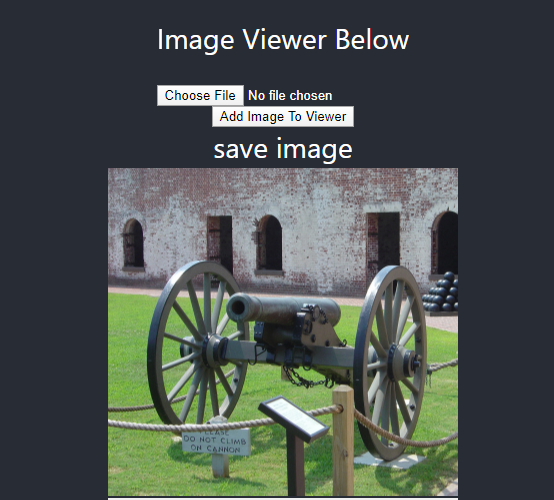Display Images in an Image Viewer - React JS
This tutorial shows how to load, display, and save images using the LEADTOOLS SDK in React.JS.
| Overview | |
|---|---|
| Summary | This tutorial covers how to load, display, and save image in a React JS application. |
| Completion Time | 15 minutes |
| Visual Studio Project | Download tutorial project (473 KB) |
| Platform | React JS Web Application |
| IDE | Visual Studio Code - Client |
| Development License | Download LEADTOOLS |
| Try it in another language |
|
Required Knowledge
Get familiar with the basic steps of creating a project by reviewing the Add References and Set a License tutorial, before working on the Display Images in an Image Viewer - React JS tutorial. Make sure that Yarn is installed so that the React application can be created quickly via the command line. If Yarn is not installed, it can be obtained from the following location:
https://classic.yarnpkg.com/en/docs/install/#windows-stable
Create the Project and Add LEADTOOLS References
To create the project structure open the command line console and cd into the location where the project is to be created. Then run the following command:
Yarn create react-app appname
The references needed depend upon the purpose of the project. For this project, the following JS files are needed and located at <INSTALL_DIR>\LEADTOOLS22\Bin\JS:
Leadtools.jsLeadtools.Controls.js
Make sure to copy both files to the public\common folder and import them in the public\index.html file.
Set the License File
The License unlocks the features needed for the project. It must be set before any toolkit function is called. For details, including tutorials for different platforms, refer to Setting a Runtime License.
There are two types of runtime licenses:
- Evaluation license, obtained at the time the evaluation toolkit is downloaded. It allows the toolkit to be evaluated.
- Deployment license. If a Deployment license file and developer key are required, refer to Obtaining a License.
Note
Adding LEADTOOLS local references and setting a license are covered in more detail in the Add References and Set a License tutorial.
Initialize the Image Viewer
With the project created, the references added, and the license set, coding can begin.
Open public\Common\ltlogic.js file. Creation of ltlogic.js is covered in the Add References and Set a License tutorial. Add the code below after the set license call to initialize the Image Viewer.
window.onload = function () {var licenseUrl = "./Leadtools/LEADTOOLS.lic.txt";var developerKey = "ADD THE CONTENTS OF YOUR LEADTOOLS.lic.key.txt FILE";lt.RasterSupport.setLicenseUri(licenseUrl, developerKey, function (setLicenseResult) {// Check the status of the licenseif (setLicenseResult.result) {console.log("LEADTOOLS client license set successfully");let ImageViewerDiv = document.getElementById("imageViewerDiv");ImageViewerDiv.style = "height: 350px; width: 350px;";const createOptions = new lt.Controls.ImageViewerCreateOptions(imageViewerDiv);this.imageViewer = new lt.Controls.ImageViewer(createOptions);this.imageViewer.viewVerticalAlignment = lt.Controls.ControlAlignment.center;this.imageViewer.viewHorizontalAlignment = lt.Controls.ControlAlignment.center;this.imageViewer.autoCreateCanvas = true;this.imageViewer.imageUrl = "https://demo.leadtools.com/images/jpeg/cannon.jpg";} else {var msg = "LEADTOOLS License is missing, invalid or expired\nError:\n";console.log(msg);alert(msg);}});}
Add the Load Image and Save Image Code
Open src\App.js file and modify the HTML with the below code:
import React from 'react';import logo from './logo.svg';import './App.css';function App() {return (<div className="App"><header className="App-header"><div class="tutorial-image"><img src={logo} className="App-logo" alt="logo" /></div><p>Loading and Saving an Image example</p><p>Image Viewer Below</p><input type="file" id="file-input" accept=".jpg,.jpeg,.png"></input><button id="addToViewer">Add Image To Viewer</button><a id="download" download="new-image-name.jpg"> save image </a><div id="imageViewerDiv"></div></header></div>);}export default App;
In ltlogic.js file, add the following code after the ImageViewer initialization code:
var fileList = document.getElementById("file-input");var download = document.getElementById("download");var btn = document.getElementById("addToViewer");btn.onclick = (function () {//create our iteratorvar i = 0;//initially set our target to the first child of the uploaded files, then iterate it so//subsequent images can be loaded in.var files = fileList.files[i];var newUrl = window.URL.createObjectURL(files);imageViewer.imageUrl = newUrl;download.style = ("display: block;");download.href = newUrl;i++;});
Run the project
Open the command line console, then cd into the root of the React project. From there, run yarn start.
This will build the React application, and the ImageViewer will now be loaded into the browser.

To load a new RasterImage into the ImageViewer, click Choose File and choose an image. Then press Add Image to Viewer to display the image. To export the image click save image and the image will begin to download.
Wrap-up
This tutorial showed how to load, display, and save images. In addition, it showed how to use the ImageViewer object.
